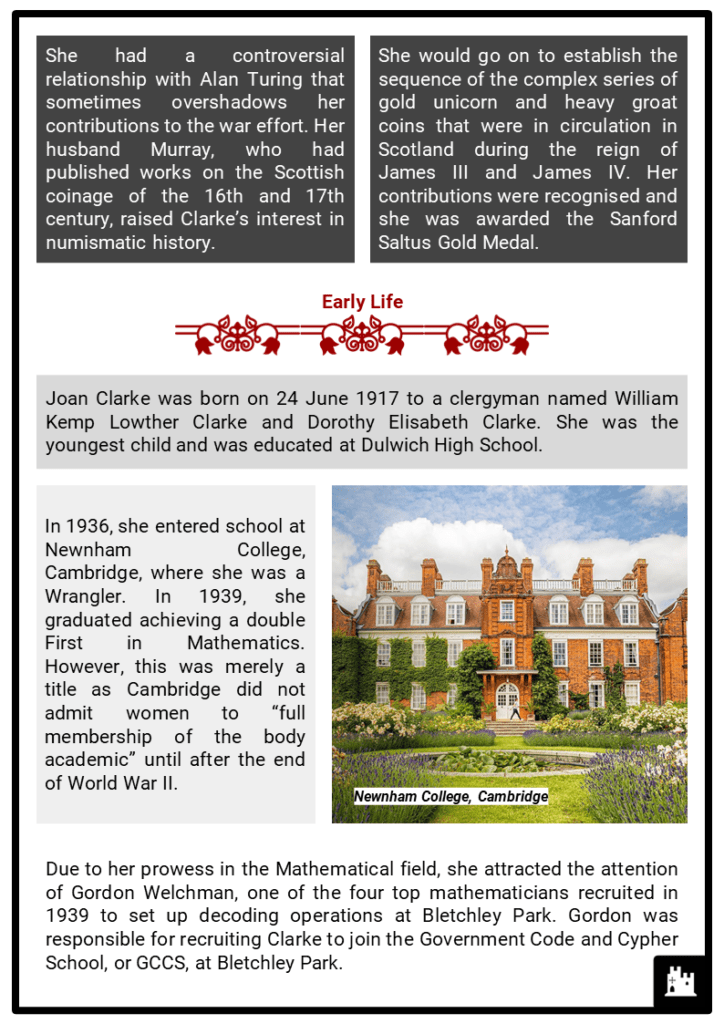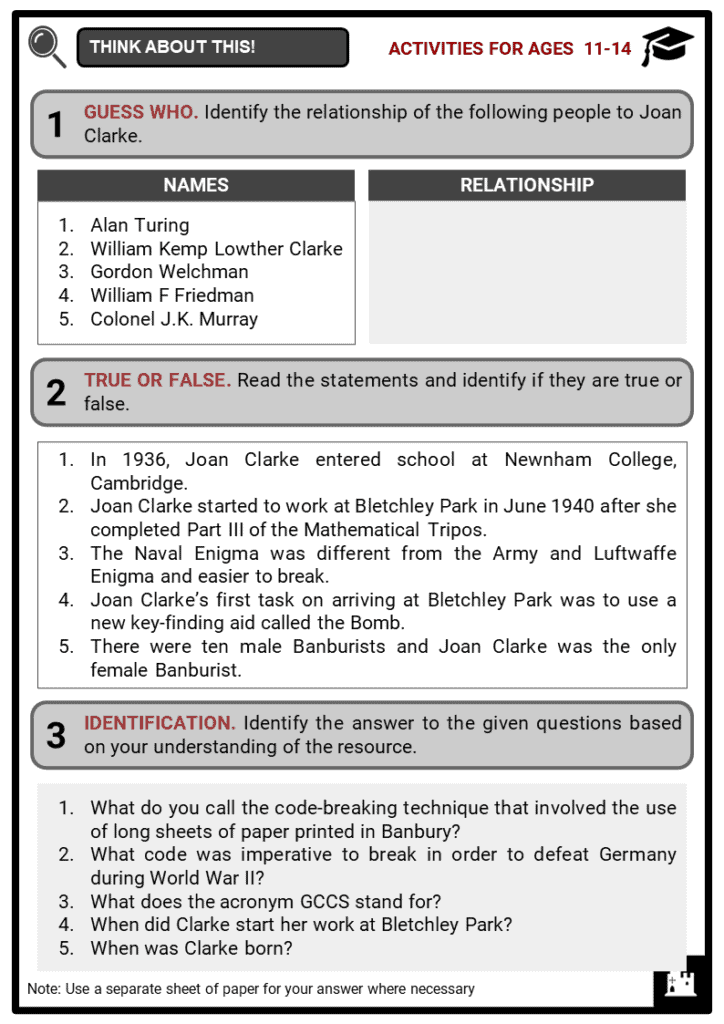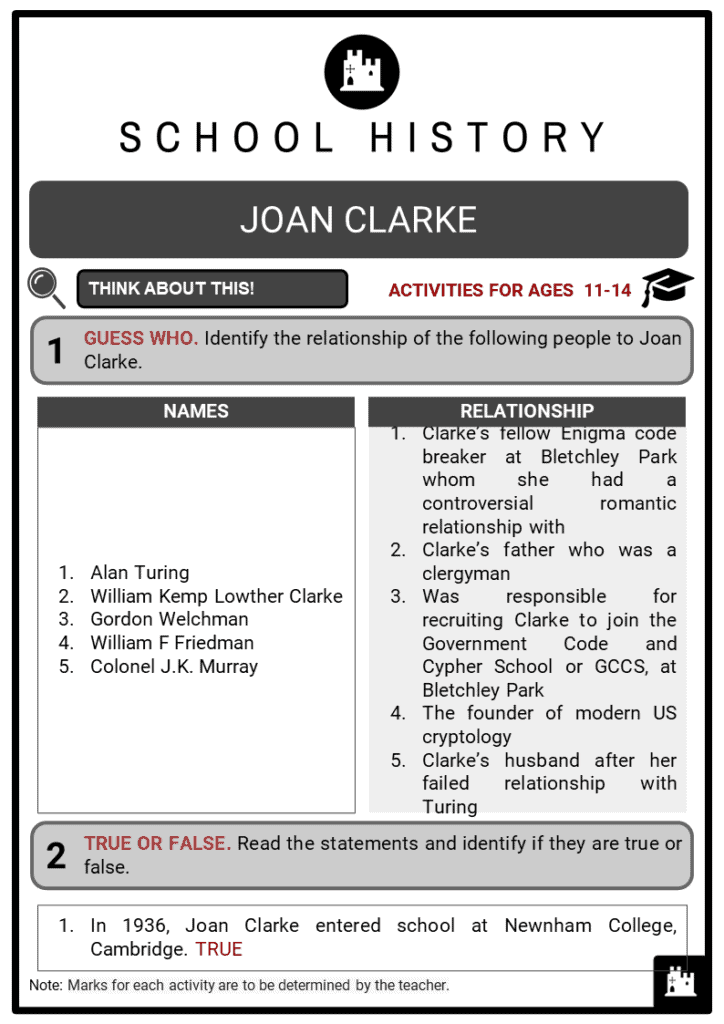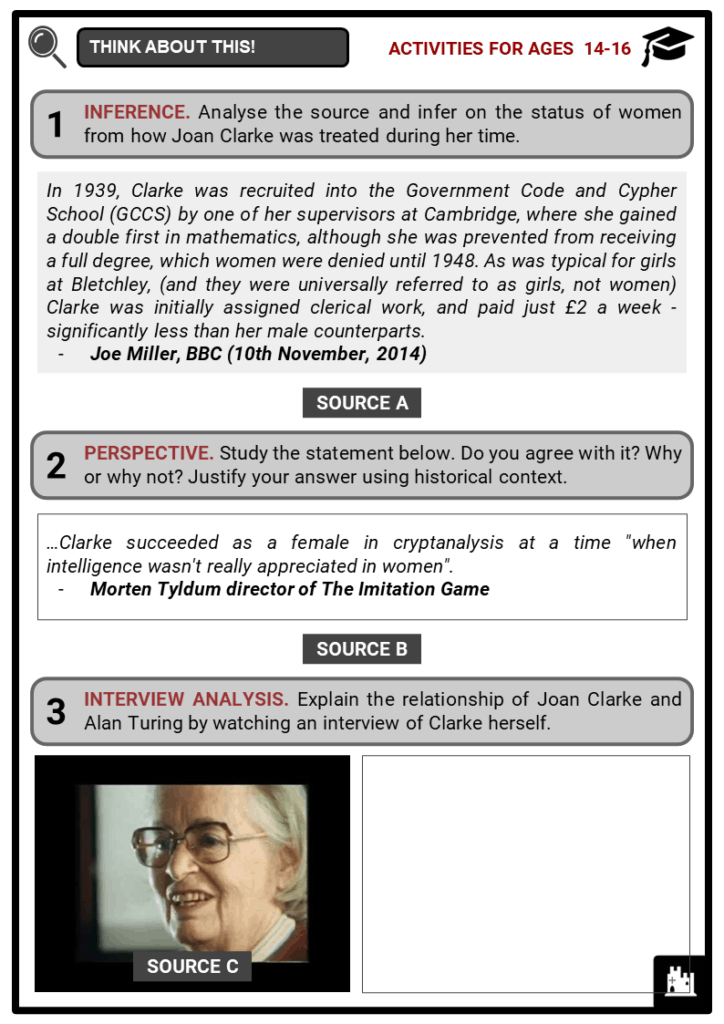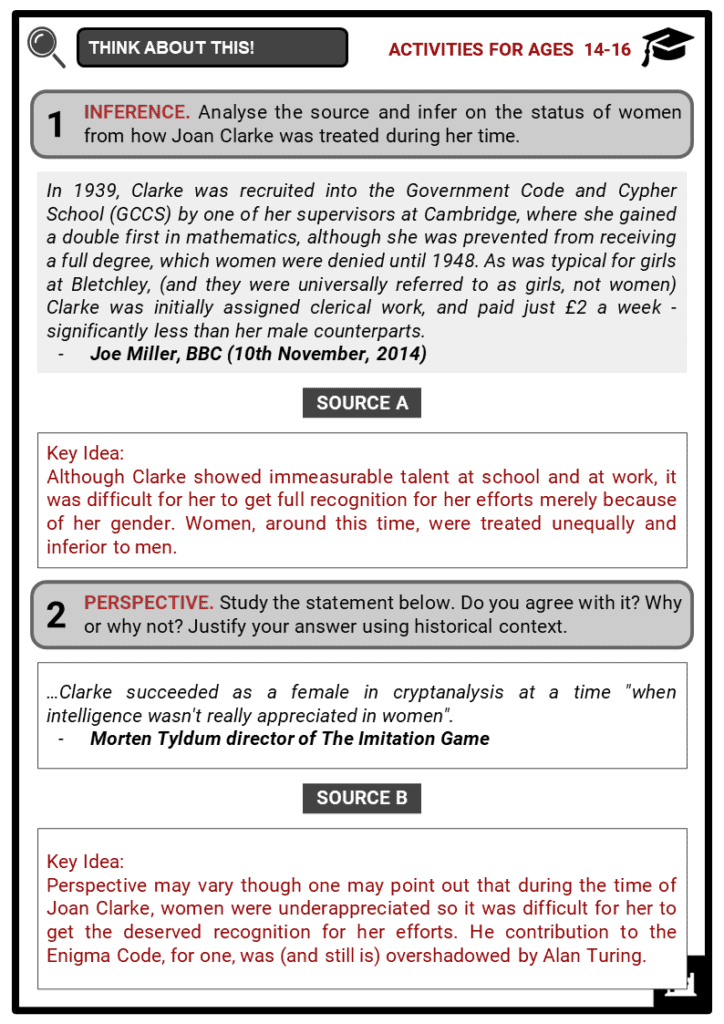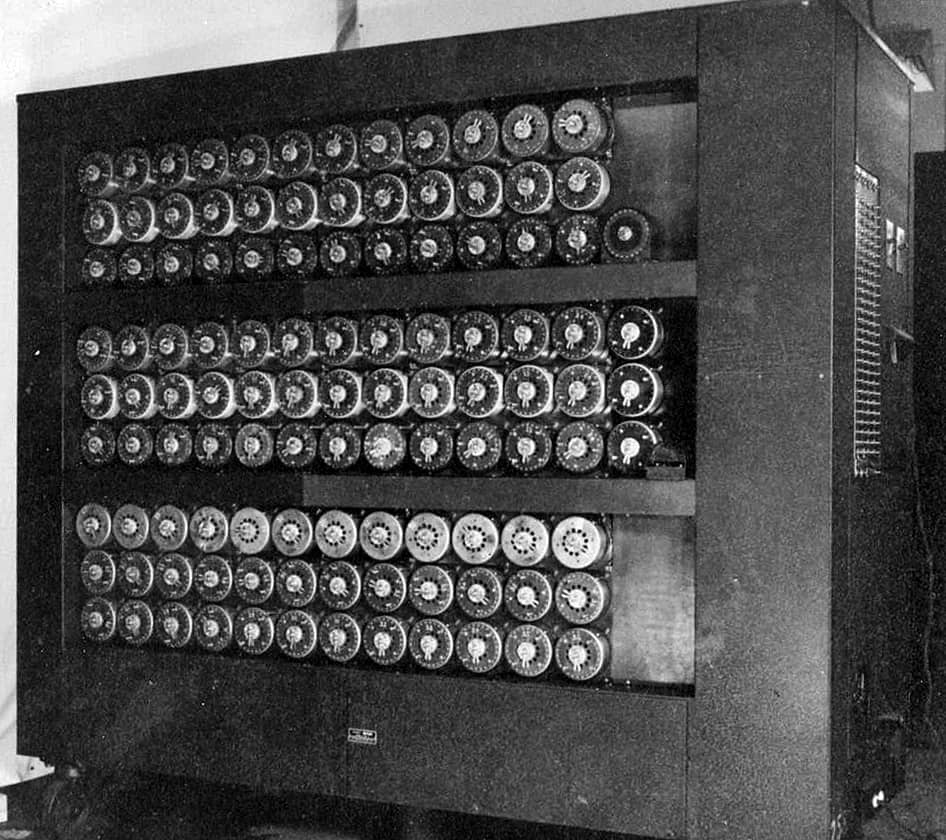Download Joan Clarke Worksheets
Do you want to save dozens of hours in time? Get your evenings and weekends back? Be able to teach Joan Clarke to your students?
Our worksheet bundle includes a fact file and printable worksheets and student activities. Perfect for both the classroom and homeschooling!
Table of Contents
Add a header to begin generating the table of contents
Summary
- The early life of Joan Clarke
- Clarke’s work as a code-breaker including the Naval Enigma Code
- Clarke’s relationship with Alan Turing
- Clarke’s life after WWII and leading to her death
Key Facts And Information
Let’s find out more about Joan Clarke!
- Joan Elisabeth Lowther Murray (nee Clarke) was an English cryptanalyst and numismatist best known for her work as a code-breaker at Bletchley Park during World War II. Her role in the Enigma project that decrypted Nazi Germany’s secret communications earned her awards and citations, such as the appointment as a Member of the Order of the British Empire, or MBE, in 1946. She was also awarded the distinguished Philippa Fawcett Prize and in 1939-1940, the Helen Gladstone Scholarship.
- She had a controversial relationship with Alan Turing that sometimes overshadows her contributions to the war effort. Her husband Murray, who had published works on the Scottish coinage of the 16th and 17th century, raised Clarke’s interest in numismatic history.
- She would go on to establish the sequence of the complex series of gold unicorn and heavy groat coins that were in circulation in Scotland during the reign of James III and James IV. Her contributions were recognised and she was awarded the Sanford Saltus Gold Medal.
Early Life
- Joan Clarke was born on 24 June 1917 to a clergyman named William Kemp Lowther Clarke and Dorothy Elisabeth Clarke. She was the youngest child and was educated at Dulwich High School.
- In 1936, she entered school at Newnham College, Cambridge, where she was a Wrangler. In 1939, she graduated achieving a double First in Mathematics. However, this was merely a title as Cambridge did not admit women to “full membership of the body academic” until after the end of World War II.
- Due to her prowess in the Mathematical field, she attracted the attention of Gordon Welchman, one of the four top mathematicians recruited in 1939 to set up decoding operations at Bletchley Park. Gordon was responsible for recruiting Clarke to join the Government Code and Cypher School, or GCCS, at Bletchley Park.
Code Breaker
- In order to defeat Germany, it was imperative to break the Enigma code. Churchill’s government searched the country for the best mathematicians, chess champions, Egyptologists and others of suitable ability who would know anything about the possible permutations of formal systems, to assist in the operation of cracking the enigma code.
- In August 1939, the GCCS was set up in privacy at Bletchley Park. Its sole mission: to break the enigma code. Bletchley Park was far safer than London for the code breakers since it was at the junction of a major road.
- This was a very difficult task; Alastair Denniston, who was to become the first Head of Bletchley Park, thought it would be impossible. He is recorded as telling his fellow code breakers: “…all German codes are unbreakable.” However, Joan Clarke and her colleagues were destined to prove him wrong, eventually.
- Clarke initially didn’t even know what the job would entail, but she accepted the challenge nonetheless. She started to work at Bletchley Park in June 1940 after she completed Part III of the Mathematical Tripos. Arriving at her destination, she was placed in Hut 8, where only women stayed and were mostly engaged in clerical work. The ratio of women to men at Bletchley Park was 8:1.
- Clarke’s first promotion at work was to Linguist Grade, even though she did not know another language. This action was engineered to enable her to earn extra money, thereby acknowledging her workload and contributions to the team. She believed she struggled to get further promotion purely because she was a woman. Commander Edward Travis later told her that she might have to enrol in the Women’s Royal Naval Service, in order to earn significantly more money, but Clarke did not want to pursue this route.
- While staying in Hut 8, she was quickly promoted to her own small room, joining a team which included Alan Turing, Tony Kendrick, and Peter Twinn. Collectively, they were applying themselves to non-routine tasks of trying to break the complex Naval Enigma – codenamed Dolphin.
- William F Friedman, the founder of modern US cryptology, wrote that a code breaker required unusual powers of inductive and deductive reasoning, much concentration, perseverance, and a vivid imagination. The fact that Joan Clarke was able to move so quickly into the male cryptology area at Bletchley Park indicates she possessed these attributes.
- The Naval Enigma was different from the Army and Luftwaffe Enigma and more complex to break. Firstly, two extra wheels had been added so there was now a choice of three from five giving a total number of 336 possible wheel orders. Secondly, to give added security, a different indicator system was applied; instead of transmitting the indicators directly, they were enciphered using bigram tables.
Naval Enigma Code
- The need for breaking the Naval Enigma code was growing greater by the day. By mid-1940, following the German occupation of France, German U-Boats now had access to the Atlantic from the Bay of Biscay. Britain had become extremely dependent on imports and was importing half of its food, and all of its oil.
- The provisions now had to come across the Atlantic from North America, and the convoys rapidly became targets for the U-boats. At one stage, Britain was only three days from running out of food and therefore, it was crucial that the Naval Enigma code was broken.
- In May 1940, matched plaintext and Enigma cypher text became available from a German patrol boat that was captured off the Norwegian Coast. Joan Clarke’s first task on arriving at Bletchley Park was to use a new key-finding aid called the Bombe, against the recovered data. This successfully resulted in Clarke and her colleagues breaking approximately six days of April traffic over a period of three months.
- By the end of 1940, rotors VI, VII, and VIII had been recovered and a library of cribs built up – the cribs were assembled by using anticipated text from German weather ships that were relaying messages in the German Meteorological cypher. This provided Clarke and the team, with the knowledge of what information to expect in a message and how the naval indicator system worked.
- Alan Turing invented a new code-breaking technique, called the Banburismus. It involved the use of long sheets of paper printed in Banbury and thus the name of the technique. The method exploited the German cryptographic mistake of wheels VI, VII, and VIII all having different positions of turnover.
- There were eight male Banburists and Joan Clarke was the only female Banburist. However, she was one of the best Banburists and was enthusiastic and fascinated with the technique.
- She would sometimes be unwilling to hand over her workings at the end of her shift and would continue to see if a few more tests would produce a result. A method known as Yoxallismus was devised to speed up this work and was named after its inventor Leslie Yoxall. Shortly afterwards, Clarke devised a method of her own to also speed up the technique, and she was told, to her surprise, that she had used pure Dillysimus.
- This was a method which had been invented by Dillwyn (Dilly) Knox, one of the few cryptographic experts of World War One, who had originally headed the attack on the German enigma. Banburismus was impossible without the Bigram substitution tables and therefore without them, very little progress against the Naval Enigma was accomplished. The breakthrough came in February and June 1941, when trawlers were captured along with cypher equipment and codes.
- Clarke and her co-workers successfully performed Banburismus for two years, only stopping in August 1943 when ultra-fast Bombes became available. The successful results of their efforts were evident immediately. Between March and June 1941, the Wolf Packs (a term used to describe the mass attack tactics used against convoys by U-boats), had sunk 282,000 tons of shipping a month. From July, the figure dropped to 120,000 tons a month and by November, to 62,000 tons.
Code Breaker
- During her stay in Hut 8, Joan Clarke developed a close friendship with her colleague Alan Turing. They became inseparable with Turing even arranging their shifts so they could work together. They spent many of their off-duty days together. Soon after, Turing proposed to Clarke and she accepted. However, a few days after the proposal, Turing confessed to Clark that he had homosexual tendencies.
- Although Turing expected this affair to end, Clarke was undeterred by his decision and the engagement continued. In this period in history, marriage for women was considered a social duty, and it was not necessary that marriage should correspond with sexual desires. They both met each other’s families but they hid their relationship from their colleagues.
- However, in late summer 1941, their engagement ended as Turing considered that his tendencies would lead to a failed marriage. They remained close friends but soon after Turing’s sexual preferences were discovered, he was imprisoned and was given estrogen injections for a year. He then committed suicide.
- Clarke and the Naval Enigma team continued to work and try to break the Dolphin Enigma as well as the Shark Enigma code. They succeeded in breaking the Dolphin Enigma, however, the Shark Enigma was taken over by the US code-breaking unit. This resulted in the relocation of the staff of Hut 8 in other parts of the Bletchley Park.
- Yet, Joan Clarke remained in Hut 8, becoming Deputy Head in 1944. She and her team continued to break the Naval Enigma until the end of the war. When the war ended in 1945, all the workers had vacated Bletchley Park and every scrap of evidence of their secret code-breaking exploits was disposed of.
After the War
- Due to her code-breaking expertise and contributions during the war, Joan Clarke was appointed a Member of the British Empire or MBE, in 1947. But her work was to remain confidential due to the restraints of the Official Secrets Act.
- She went on to marry Colonel J.K. Murray in 1952, though they did not have any children. Due to her husband’s poor health, they moved to Scotland where they both developed a keen interest in Scottish history. This introduction into history from her husband also pushed Clarke’s interest to study numismatic history.
- In 1962, they returned to England and Clarke rejoined the GCHQ, where she remained until retiring at the age of 60 in 1977. The lifting of the Official Secrets Act in 1974 set loose the details of the code breaker’s brilliant work, and it became widely known throughout the world.
- In 1986, Clarke’s husband died. She moved near Oxford and continued her numismatic research. In 1987, she was awarded the Sanford Saltus Medal, the Society’s premier distinction, voted for by its members for scholarly contributions to British Numismatics.
Aftermath
- Joan Clarke died on 4 September 1996 at her home in Oxford. The full extent of Clarke’s mathematical contributions and accomplishments sadly still remains unknown due to the continuing secrecy amongst cryptanalysts. Clarke’s work is still somewhat overshadowed by her relationship with Alan Turing.
- Nonetheless, it is clear that Joan Clarke played a notable role in Britain’s crucial achievements during World War II. It is also clear that her mathematical expertise on the Naval Enigma helped shorten the war and thus saved thousands of lives.
Image sources:
- https://upload.wikimedia.org/wikipedia/en/3/35/Joan_Clarke_%28cryptanalyst%29.jpg
- https://en.wikipedia.org/wiki/Bletchley_Park#/media/File:Bletchley_Park_Mansion.jpg
- https://en.wikipedia.org/wiki/Bombe#/media/File:Wartime_picture_of_a_Bletchley_Park_Bombe.jpg
- https://en.wikipedia.org/wiki/Alan_Turing#/media/File:Alan_Turing_Older.jpg


